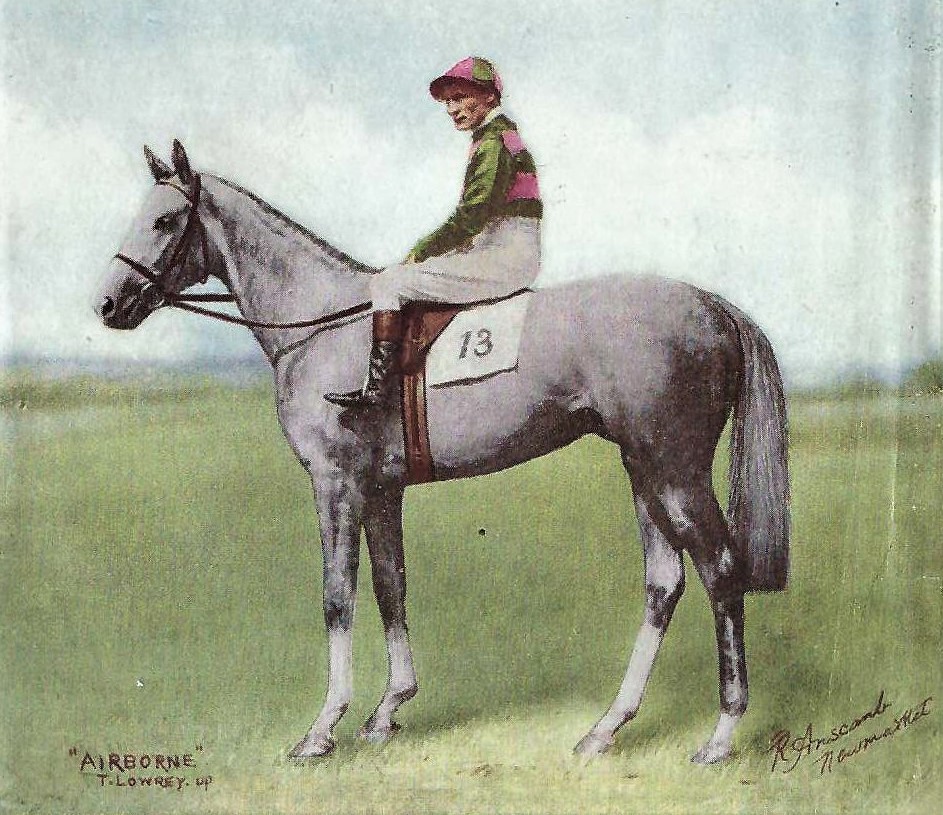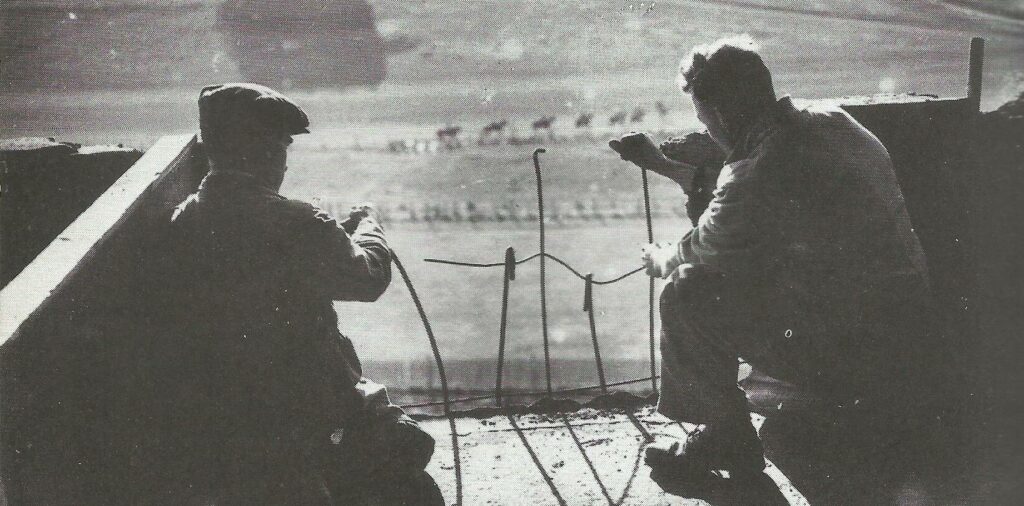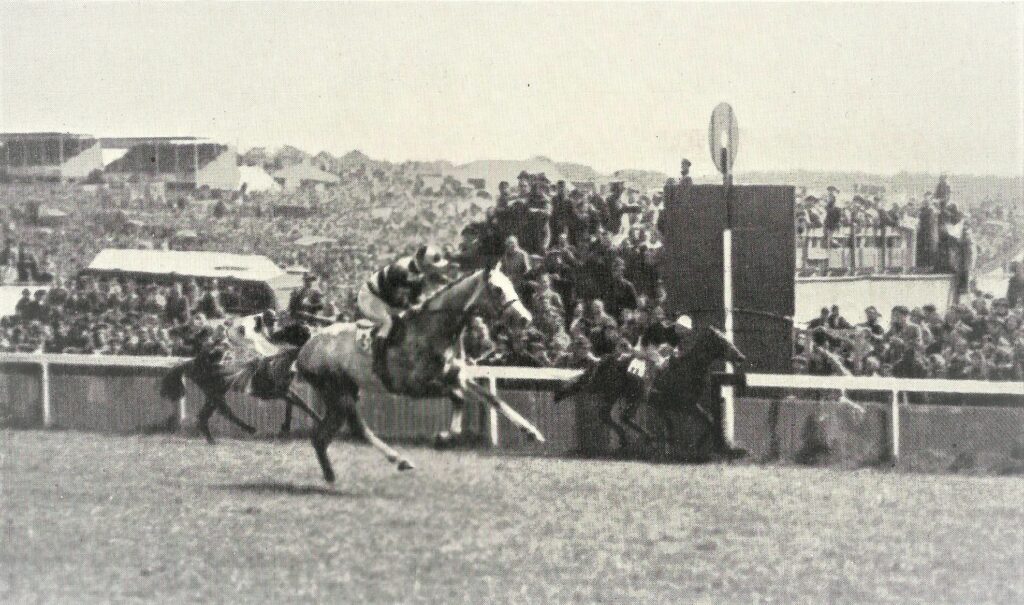AIRBORNE 1946
The last of four grey Derby winners ?

On Wednesday 5 June 1946, the Derby returned to Epsom after a gap of six years. Years, in which the Army used the Downs for military operations, turning the Prince’s Stand into the Officers Mess and, in 1943, in the midst of a national food shortage, the Surrey War Agricultural Committee finally agreed to relinquish its claim to plough up the gallops.

Inevitably, being near to London, Epsom was subject to the occasional air raid and, after one such attack received bomb damage to the enclosures and the Grandstand. Nevertheless, all were patched up in time for Derby Day, when enormous crowds braved heavy showers to see for the first time the King and Queen, Princess Elizabeth and Queen Mary drive up the course from Tattenham Corner. However, with food subject to rationing the catering was basic at best and not a top hat was seen in the Members Enclosure.
After Gordon Richards had won the first two races on Gold Sorrel (9-2) and Gold Paint (4-1), the Derby betting looked comparatively open, with Happy Knight, winner of the Two Thousand Guineas starting 5-1 favourite and the next four home – Khaled, Radiotherapy, Gulf Stream and Edward Tudor, all by Hyperion – priced between 7-1 and 100-9. Airborne, at 50-1, was a popular each-way choice for R.A.F. servicemen and their wives or sweethearts.

The field of 17 ‘off’ and running, Gulf Stream led Happy Knight, Khaled and Peterborough up to the top of the hill. Little changed until Tattenham Corner, where Khaled and Peterborough disputed the lead, but once into the straight Gordon Richards looking to land a treble, took Edward Tudor to the front, followed by Gulf Stream and Radiotherapy. At the two-furlong marker Airborne started his run on the wide outside, while Gulf Stream and Radiotherapy were racing neck and neck to below the distance. Inside the final 100 yards Airborne’s acceleration proved decisive as he caught and passed Gulf Stream (the author’s pocket money choice), close home to win by a length, with Radiotherapy two lengths away third. Not to be denied, Gordon Richards won the next race on the 2-y-o filly, Neocracy, who went on to be the dam of Tulyar (1952 Derby & St Leger).
Bred by Lt-Colonel Harold Boyd-Rochfort at the Middleton Park Stud in Ireland, Airborne, was by the Ascot Gold Cup winner Precipitation out of the unraced grey mare Bouquet and purchased by John Ferguson as a yearling for 3,300 guineas.
Airborne is the last of the four grey horses to have won the Derby. The previous three were:
Gustavus in 1821. gr.c. Election – Lady Grey
Tagalie in 1912 gr.f. Cylene – Tagale
Mahmoud in 1936 gr.c. Blenheim – Mah Mahal
Trained by Dick Perryman at Newmarket, Airborne ran four races there as a juvenile without success. However, he did run ‘fairly well’ when fourth in the Dewhurst behind Hypericum and, the following year, he reappeared at Newmarket’s First Spring Meeting with a ‘very promising’ third in the Hastings Stakes. Two weeks later, staying on well, he won a good class maiden at the Second Spring Meeting.
After the Derby, Airborne went on to win the Princess of Wales’s Stakes, the Stuntney Stakes (dead-heated with Fast and Fair) and the St Leger. His finale, in October, came in the King George VI Stakes over two miles at Ascot, in which he finished third to the French crack Souverain.
Airborne could not be trained as a four-year-old and retired in 1948 to the Aislabie Stud at Stetchworth, Newmarket at a fee of 400 guineas. Although not a great success, he did get the Irish Oaks winner Silken Glider and the top-class chaser Frenchman’s Cove, winner of the Whitbread Gold Cup. Airborne died from heart failure on 11 September, 1962.
Tommy Lowrey (1911-1991), was born in Felling, County Durhan, the son of a coal miner. He became apprentice to F. Leader at Newmarket, later winning the 1929 Liverpool Autumn Cup, on Mohawk (5y-7st-4lb) for Malton trainer, Capt. Charles Elsey. The war over, he went to ride for Dick Perryman, winning the 1945 St Leger on Chamossaire, then adding the Derby and St Leger the following year on Airborne. Lowrey, always known as a stylish jockey had a career total of 508 winners.
Dick Perryman (1903-1976), having served his apprenticeship with G. F. Leader at Newmarket, he later succeeded Tommy Weston as first jockey to the 17th Earl of Derby at the close of 1934. Perryman rode three Classic winners – all in the One Thousand Guineas – Pillion for Anthony de Rothschild in 1926, Tideway for Lord Derby in 1936 and Dancing Time for 1st Baron Glanely in 1941. After seriously injuring his arm in a motor accident later in 1941, Perryman took to training from Beaufort House, Newmarket, from where he made a good start with Chamossaire (1945 St Leger) and Airborne. But although training until 1967, he never had another major winner. In the years after, he was greatly involved with the running of his Aislabie Stud at Stetchworth.
For more Racing History see Michael’s Books for Sale.
To see Michael’s interviews go to the foot of About Michael